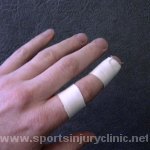Nadal Gives Federer the Finger

Monte Carlo Masters Cup final result: Nadal defeats Federer in 4 (although two of the sets went to tiebreaks, and Fed won one of them). Controversy from the match: Immediately after Fed breaks Nadal to go up 1-0 in the third set (after losing the first and winning the second in the breaker), Nadal calls for the trainer to, get this, have his finger retaped. HIS FINGER RETAPED! It was a naked display of gamesmanship and Fed did well to endure it with dignity. Obviously, Nadal was hanging in there with the old tape job, waiting until the momentum fully swung Fed's way before calling for the trainer.
That said, Federer still would have lost the match. He's not exactly sharp on the red clay yet, although he seems to be slowly warming to the tactical challenge. Nadal was playing exceptionally well. On clay, he tends to go for quite a lot against Federer, combing the discomfort level of forcing Fed to deal with brutally spun crosscourt forehands to his backhand with aggressive, go-for-the-lines winners. This combo, which was firing on all eight for Nadal, kept Fed massively out of sorts the entire match. He was missing shots all over the place, generally failing to create the beautiful pace that he has become so famous for. Another one of those Fed-Nadal matchup where it seemed right from the get-go that Fed would be very, very unlikely to win.
From Fed's POV, he has to be glad he managed the two tiebreaks. I maintain that his campaign this year is to capture the French Open, and he at least started well, getting the final in Monte Carlo, in impressive fashion, and facing his likely final opponent at Roland Garros. You can see the adjustments: easing back on serve, attempting to work the angles with spin, throwing in the odd drop shot here and there.
Meanwhile, Nadal looks to be in nearly peak form for red clay. His game is flowing. On several occasions at Monte Carlo, he caught Fed completely flat-footed with droppers from the backcourt. Nobody except Nadal can consistently catch Fed flat-footed.
What Federer needs to do now is ponder the defeat and adjust further. He needs to tighten up and make fewer errors (namely: stop framing backhands). He also needs to transition from backcourt to net more effectively. He will get passed, but keeping Nadal under constant pressure will ultimately cause the Spaniard's backhand to break down. A win against Nadal would be a five-setter on clay, but it would still be a win. Fed can do it. He's the best chance for a player of his type to adapt to clay—best chance since Lendl. Better, really. He knows that his ball gets "softer" on the clay, lacks the heaviness of some of the other clay-court guys, so for his the key is fitness, patience, and careful shot selection. For example, in the MC final, when he constructed point and finished them off at the net, he did well. When he just hung back and tried to move Nadal around, he struggled. Nadal is a great clay-courter, but he still can't utilize the entire court. Fed can.
Two things Fed needs to do more of: drop shot; and lob. Most know that he detests both shots. He feels that destroy the purity of the rally. But on clay, both are essential. When he dropped Nadal, he created the opportunity to win points. Lobbing, however, was abysmal. I saw him attempt one, off the backhand. It was terrible. He should note that when McEnroe nearly won the French back the ’80s, he utilized both drop shot and lob very effectively.
Nadal? What can you say? He's the favorite going into the French. Not often that you would rank Fed, number one in the world, as the underdog, but there you have it.
And Monte Carlo? Incredibly beautiful, but once again, because of the way it's televised, nearly impossible to see the ball. There must be a way to rectify this. It's really strange to see the players swing and have to imagine where the ball is.




